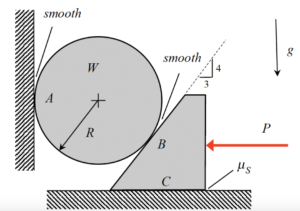Problem statement
Solution video
DISCUSSION THREAD

Please post questions here on the homework, and take time to answer questions posted by others. You can learn both ways.
Problem statement
Solution video
DISCUSSION THREAD

You must be logged in to post a comment.
I'm wondering how to figure out the second part of the problem. Since both surfaces are smooth, neither has any friction, so would it just slip at B (that is just what I think intuitively though, as from the math I might say it would slip at A)?
My guess would be that it slips on the surface with less normal force, because there's less force pushing the disk against that surface. (So, since the normal force at A is just the horizontal component of the normal force at B, it will slip at A.)
I think it would slip at A because of how the normal force is acting on the blocks. Since there is less of a force acting on the surface, it slips on the surface with less normal force. So A.